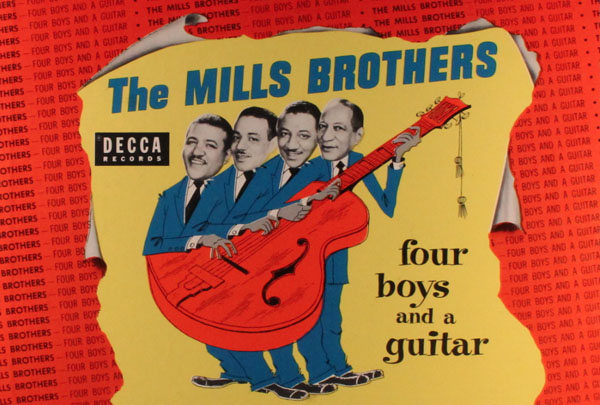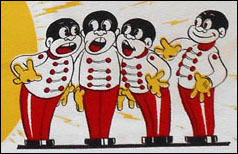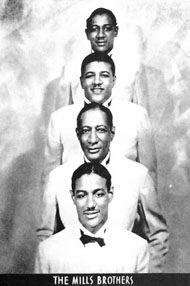
When the Mills Brothers — “Four Boys and a Guitar” — burst upon the New York music scene in the fall of 1931, they hit with a loud and palpable BANG! It didn’t take long for imitators to rouse themselves.
And although the Mills Brothers appeared in three of Max Fleischer’s “Screen Songs” cartoons, other studios went out of their way to obtain the Mills Brothers sound if needed.
It is curious to note that most of the cartoons that use fake Mills Brothers on their soundtracks were made on the West Coast. I have never herd of such a sound showing up on another Max Fleischer short (made either in New York or in Miami), or in a Terrytoons short, or in a Van Beuren short.
 The earliest use of a Mills Brothers-soundalike appears to be in Toyland Broadcast, one of the early “Happy Harmonies” done by Hugh Harman and Rudolf Ising for an M-G-M release. At one point near the end of the cartoon, four toy soldiers get their faces pelted with chocolate. One picks up a guitar, another cups his hands at his mouth, and we’re off to the races, as this group does a lively and lifelike impression of the Mills Brothers on “Jungle Fever”, a song that the Mills Brothers introduced in Operator 13, an M-G-M feature starring Clark Gable and Marion Davies. Here, it gets an elaborate production-number treatment, and follows the arrangement of the Mills Brothers’ commercial record of the piece.
The earliest use of a Mills Brothers-soundalike appears to be in Toyland Broadcast, one of the early “Happy Harmonies” done by Hugh Harman and Rudolf Ising for an M-G-M release. At one point near the end of the cartoon, four toy soldiers get their faces pelted with chocolate. One picks up a guitar, another cups his hands at his mouth, and we’re off to the races, as this group does a lively and lifelike impression of the Mills Brothers on “Jungle Fever”, a song that the Mills Brothers introduced in Operator 13, an M-G-M feature starring Clark Gable and Marion Davies. Here, it gets an elaborate production-number treatment, and follows the arrangement of the Mills Brothers’ commercial record of the piece.
Harman and Ising would also get to work in takeoffs on the Mills Brothers in two of their “black frog” cartoons–The Old Mill Pond and Swing Wedding. All three cartoons have been well and truly written up in these pages before.
 Over at Termite Terrace, the merry mirthsters at Leon Schlesinger’s studio that were redefining the animated cartoon did not waste much time before they wound up using a vocal group imitating the Mills Brothers (The Basin Street Boys?). Curiously, they didn’t call attention to themselves in doing this the first time–they just threw it in, as we see the cabs dancing at the “Taxi Dance Hall” to a Mills Brothers-inspired version of the title song to Streamlined Greta Green.
Over at Termite Terrace, the merry mirthsters at Leon Schlesinger’s studio that were redefining the animated cartoon did not waste much time before they wound up using a vocal group imitating the Mills Brothers (The Basin Street Boys?). Curiously, they didn’t call attention to themselves in doing this the first time–they just threw it in, as we see the cabs dancing at the “Taxi Dance Hall” to a Mills Brothers-inspired version of the title song to Streamlined Greta Green.
Over the next few years, Warner Bros. cartoons did several other cartoons ‘of color’. And yes, they couldn’t avoid Mills Brothers knockoffs — not in Clean Pastures nor in Tex Avery’s The Isle Of Pingo-Pongo.
I know that latter cartoon used to run on Skipper Frank’s afternoon show on KTLA (5) in the early 1960’s.. I can remember that jivey version of “Sweet Georgia Brown”, with the added participation of a Fats Waller takeoff.
But sometimes, Warners would put one of these scenes in a cartoon that you’d not expect to have it. Footage from Clean Pastures (the “Swing For Sale” number) was lifted almost verbatim for a sequence in Have You Got Any Castles?, one of those midnite-in-a-bookshop cartoons that Warners loved to do.
Even more curious is the appearance of four matches whose flames become the head of Four Mills Brothers wannabees in Wholy Smoke, as they start the festivities with a song (set to “Mysterious Mose”) called “Little Boys Shouldn’t Smoke”–which has a lot of other celebrity caricatures as well.
Even Columbia got into the swing of things–literally. Swing Monkey Swing would not be complete without a Mills Brothers takeoff livening things up–and, sure enough, there they are.
This leads to speculation as to who might have supplied the harmonies on these cartoons.
In the middle 1930’s, two “colored” vocal groups were working Hollywood’s night clubs and film studios.
The Four Blackbirds were active around 1934-35, making their own Vocalion records, and backing up Cliff Edwards on one of his sessions.. Three guys and a gal, with guitar backing
Beginning around 1936, a group called “The Five Jones Boys”–with not a Jones of any kind in its membership–began geting work. Their records were also successful–especially their Variety release of “Mr. Ghost Goes To Town”.
In 1937, the three male members of the Four Blackbirds got together with the Five Jones Boys, got together with guitarist Oscar Moore, and cut a session for Decca and appeared in two M-G-M live-action film shorts. They called themselves “The Jones Boys Sing Band”, and their arrangements were nothing short of amazing—with performances to match, especially on the Decca record of “Pickin’ A Rib”.
Now, unless pay stubs come along, we don’t know if either of these groups did soundracks for these cartoons. But it is interesting to speculate, isn’t it?
Parenthetically almost the only other black vocal group to get the cartoon treatment was The Ink Spots — and that would come in Magical Maestro, one of Avery’s richly-developed comic japes.
Of course by this time, real kids were gathering on street-corners, singing, inspired by the Mills Brothers and the rest, getting better and better with practice. And that led to one of the early forms of rock-and-roll – Doo-Wop!


 James Parten has overcome a congenital visual disability to be acknowledged as an expert on the early history of recorded sound. He has a Broadcasting Certificate (Radio Option) from Los Angeles Valley College, class of 1999. He has also been a fan of animated cartoons since childhood.
James Parten has overcome a congenital visual disability to be acknowledged as an expert on the early history of recorded sound. He has a Broadcasting Certificate (Radio Option) from Los Angeles Valley College, class of 1999. He has also been a fan of animated cartoons since childhood.












































Thank you for pointing out the obvious: were it NOT for the “Four Boys and a Guitar”, not only would there be no doo-wop–hip-hop (or beatboxing, at the very least)–also would not exist!